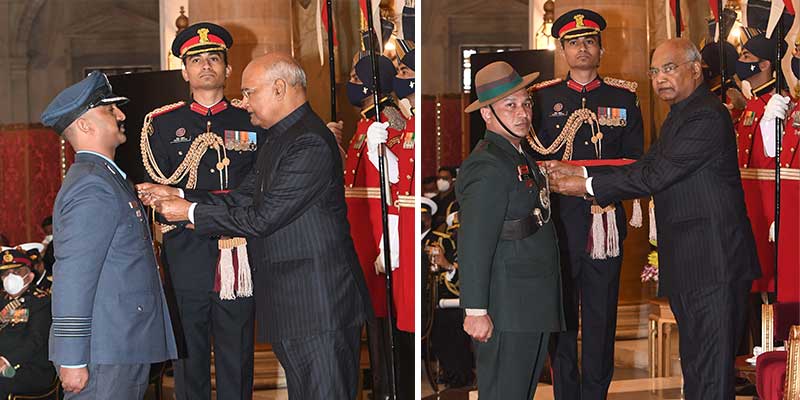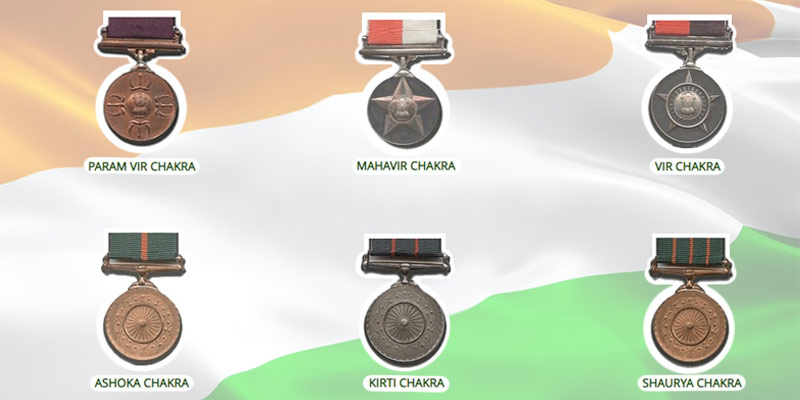- India
- Nov 22
Explainer / Gallantry awards in India
President Ram Nath Kovind presented gallantry awards and distinguished service decorations at a ceremony held at Rashtrapati Bhavan in New Delhi.
Group Captain Abhinandan Varthaman, who downed an enemy jet during an aerial combat with Pakistan in 2019 and was held captive for three days in that country, was honoured with the Vir Chakra award.
Wing Commander Varthaman (now Group Captain) downed the Pakistani jet on February 27, 2019, before his MiG 21 Bison jet was hit.
The fighter pilot of the Indian Air Force has been decorated with India’s third-highest wartime gallantry medal for displaying an “exceptional sense of duty” during the dogfight, the award citation said.
The award ceremony was attended by Prime Minister Narendra Modi, Defence Minister Rajnath Singh and several other dignitaries.
Gallantry awards in India
• Post-Independence, first three gallantry awards namely Param Vir Chakra, Maha Vir Chakra and Vir Chakra were instituted by the government of India on January 26, 1950 which were deemed to have effect from August 15, 1947.
• Thereafter, other three gallantry awards — the Ashoka Chakra Class-I, the Ashoka Chakra Class-II and the Ashoka Chakra Class-III — were instituted on January 4, 1952, which were deemed to have effect from August 15, 1947. These awards were renamed as Ashoka Chakra, Kirti Chakra and Shaurya Chakra respectively in January 1967.
• These gallantry awards are announced twice in a year — first on the occasion of the Republic Day and then on the occasion of the Independence Day.
• Param Vir Chakra: It is India’s highest military decoration awarded for displaying distinguished acts of valour during wartime whether on land, at sea or in the air.
• Maha Vir Chakra: It is the second highest gallantry award for acts of conspicuous gallantry in the presence of the enemy whether on land, at sea or in the air.
• Vir Chakra: It is India’s third-highest war time gallantry medal awarded for acts of bravery in the presence of the enemy, whether on land or at sea or in the air.
• Ashoka Chakra: It is the highest military award during peacetime for valour, courageous action or sacrifice.
• Kirti Chakra: It is awarded for conspicuous gallantry otherwise than in the face of the enemy.
• Shaurya Chakra: It is awarded for gallantry otherwise than in the face of the enemy. It is third in order of precedence of peacetime gallantry awards.
• Sena Medal: It is awarded for acts of exceptional devotion to duty or courage in the Army.
• Nao Sena Medal: It is awarded for individual acts of exceptional devotion to duty or courage in the Navy.
• Vayu Sena Medal: It is awarded for individual acts of exceptional devotion to duty or courage in the Air Force.
• Mention in Despatches: It was instituted in 1950 for distinguished and meritorious service in operational areas and acts of gallantry which are not of a sufficiently high order to warrant the grant of gallantry awards. Names may be included posthumously.
• Bar: If a recipient of the medal is subsequently awarded the medal again, every such further award shall be recognised by a Bar to be attached to the riband.
Distinguished Awards
• Sarvottam Yudh Seva Medal: It was instituted in 1980 to recognise the distinguished service of the most exceptional order during war/conflict/hostilities. The medal may be awarded posthumously.
• Param Vishisht Seva Medal: It was instituted in 1960 to recognise distinguished service of the most exceptional order. The medal may be awarded posthumously.
• Uttam Yudh Seva Medal: It was instituted in 1980 for distinguished service of an exceptional order during war, conflict or hostilities. The medal may be awarded posthumously.
• Ati Vishisht Seva Medal: Vishisht Seva Medal Class II, which was instituted in 1960, was redesignated as Ati Vishisht Seva Medal in 1967. It is awarded for distinguished service of an exceptional order. The medal may be awarded posthumously.
• Yudh Seva Medal: It was instituted in 1980 for distinguished service of a high order during war/conflict/hostilities. The medal may be awarded posthumously.
• Vishisht Seva Medal: It was instituted in 1960 and as VSM Class-III to recognise the distinguished service of a high order. It was renamed in 1967 as Vishisht Seva Medal.
Manorama Yearbook app is now available on Google Play Store and iOS App Store


